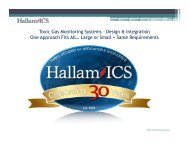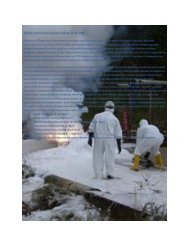SESHA 2011 Program Book - Semiconductor Safety Association
SESHA 2011 Program Book - Semiconductor Safety Association
SESHA 2011 Program Book - Semiconductor Safety Association
You also want an ePaper? Increase the reach of your titles
YUMPU automatically turns print PDFs into web optimized ePapers that Google loves.
3:15 pm Break & Raffle Drawing, Exhibit Hall<br />
3:45 pm Research of Reduction Carbon Dioxide<br />
Emission by Applying Microalgae Biotech in <strong>Semiconductor</strong><br />
Factory<br />
Ching-Lung, C; Powerchip Technology<br />
Industrial activities have improved human life, but<br />
also have increased greenhouse gases (GHG) emission<br />
into atmosphere, to cause the rising of the Earths average<br />
temperature and the other serious environmental<br />
problems. For solving these problems, there are many<br />
carbon reduction technologies are under development<br />
and application fast, such as physical treatment, chemical<br />
treatment and biological fixation. Today we plant<br />
a lot of trees to fix and transfer carbon dioxide(carbon<br />
sink) for the sake of carbon reduction. Therefore, carbon<br />
capture and storage have also been considered as<br />
an indispensable option to reduce carbon emission. Extensive<br />
research has been conducted to evaluate the feasibility<br />
of large-scale permanent carbon storage in oil<br />
fields and ocean beds. These carbon storage methods<br />
appear to be the potential solution for carbon reduction,<br />
but the highly cost, long-term stability, carbon reduction<br />
effect remains questionable. Microbial photosynthesis,<br />
particularly by microalgae, is now being reconsidered as<br />
a viable technology to reduce carbon. These processes<br />
are also attractive because the microbial extracts may<br />
possess substantial commercial values such as dietary<br />
supplements and fuels. In this study, we design an integrated<br />
CO2 biofixation system that consists of three<br />
parts, including CO2 scrubber system, and submerged<br />
membrane harvesting system. A laboratory-scale system<br />
was built to investigate the technical feasibility, and the<br />
pilot-scale system has been subsequently installed on<br />
semiconductor manufacture factory to reduce CO2 that<br />
emit from boiler process exhaust. The boiler use nature<br />
gas as fuel, and its exhaust contain CO2 about rather<br />
consistent at 16.1% and its temperature fluctuates between<br />
50 and 60°C. We used wet scrubber to wash CO2<br />
into water and supplied the carbon resource to grow microalgae<br />
in the close-loop photobioreactors, and microbial<br />
photosynthesis processes are designed to achieve<br />
faster growth rate, better carbon fixation efficiency, and<br />
greater growth density, then we generate and gain the<br />
concentrated microalgae in the membrane harvesting<br />
system. Microalgal CO2 Fixation appear to be a potential<br />
solution for carbon reduction in the semiconductor<br />
fab. In the future, we will plan to combine regenerating<br />
energy to develope a cost-effective energy-saving systems<br />
and try to test the large module. The test results<br />
15<br />
will provide reliable data to reduce carbon emissions in<br />
the semiconductor fab.<br />
4:30 pm Environmentally Benign In-Line Cleaning<br />
Solutions for Advanced <strong>Semiconductor</strong> Manufacturing<br />
Chen, T, Hogan, T, Korzenski, M; ATMI, Intermolecular<br />
The immersion lithography has been critical to the<br />
continued performance improvements of semiconductor<br />
devices as well as to the overall economics of the semiconductor<br />
industry because it offers both a technical solution<br />
to meeting the minimum resolution for the shrinking<br />
critical dimension in a device and a cost-effective<br />
approach to continue using large amounts of the existing<br />
lithographic tooling infrastructure and patterning materials.<br />
However in order to achieve similar defectivity<br />
levels as compared to dry lithography, enormous efforts<br />
have to be put on identifying, classifying, determining the<br />
root cause of various defects associated with immersion<br />
lithography, and eventually addressing the defectivity issues<br />
without affecting the high process yields. An efficient<br />
in-line cleaning of the immersion hood periodically is a<br />
part of the strategy to maintain the low defectivity level<br />
in semiconductor industry. With the aid of combinatorial<br />
screening tools, we developed novel, low odor, and environmentally<br />
benign formulations for a time and cost effective<br />
in-line cleaning method of the immersion hood.<br />
10:00 am-3:15 pm<br />
PV/Solar Manufacturing EHS<br />
Sonora C<br />
10:00 am SF6 Massive-Scale Decomposition Technology<br />
and Clean Development Mechanism Project<br />
in TFT-LCD Industry, South Korea<br />
Choi, J; KDIA<br />
South Korean LCD industry has been investing new<br />
generation LCD fab since early 2000s, thus it has the line<br />
up from 2nd generation to 8th generation of LCD fab. As<br />
production expanded, greenhouse gas emission also has<br />
been increased. Within the greenhouse gas, SF6 gas is the<br />
major gas, which is used as an etching agent in dry etching<br />
process and its global warming potential is over 20,000<br />
times higher than CO2. SF6 abatement technology was<br />
already developed, which can treat about 1 cubic meter<br />
of exhaust per minute. However, as the LCD generation<br />
increasing, the amount of process exhaust has been increasing<br />
sharply. In this circumstance, to abate SF6 gas,<br />
several small-scaled abatements should be installed in<br />
point-of-use (POU), i.e. right after each process chamber<br />
of dry etchers. Thus, there are two major problems for SF6




